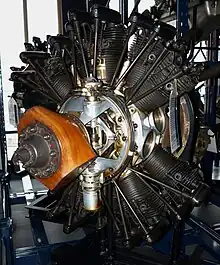Armstrong Siddeley Jaguar
The Armstrong Siddeley Jaguar is an aircraft engine developed by Armstrong Siddeley. The Jaguar was a petrol-fuelled air-cooled 14-cylinder two-row radial engine design. The Jaguar III was first used in 1923, followed in 1925 by the Jaguar IV and in 1927 by the Jaguar VI. In 1925 the Jaguar became the first production aero engine incorporating a geared supercharger.[1]
| Jaguar | |
|---|---|
 | |
| Armstrong Siddeley Jaguar IV | |
| Type | Radial engine |
| National origin | United Kingdom |
| Manufacturer | Armstrong Siddeley |
| First run | 21 June 1922 |
Design and development
The Jaguar was developed from the Royal Aircraft Factory RAF.8 design proposal of 1917, and was engineered to use a gear-driven supercharger. First run on 21 June 1922 initial performance was not as expected; as a result the stroke was increased to 5.5 in (139.7 mm) on all variants after the Jaguar I. Throughout its career the Jaguar suffered from vibration due to the lack of a crankshaft centre bearing.[2]
The most powerful version of the engine, the Jaguar VIC, produced a maximum of 490 hp (365 kW) on takeoff at 1,950 rpm and weighed 910 lb (413 kg).[3] The later Lynx was designed using one row of Jaguar cylinders.[4]
Variants
- Jaguar I
- 1922, 300 hp.
- Jaguar II
- 1923, 385 hp, increased stroke, capacity 1,512 cu in (24.8 L).
- Jaguar III
- 1923, 385 hp.
- Jaguar IIIA
- 1923, 380 hp.
- Jaguar IV
- 1925, 385 hp, twin carburettors
- Jaguar IVA
- 420 hp, Geared propeller drive.
- Jaguar IVC
- 1928, 400 hp, revised connecting rod design, enclosed valve gear.
- Jaguar IV(S)
- 1925, 365 hp, fully supercharged.[nb 1]
- Jaguar V
- 1928.
- Jaguar VI
- 1927.
- Jaguar VI(S)
- 1928, supercharged version of Jaguar VI.
- Jaguar VIC
- 1927, 470 hp, geared propeller drive version of Jaguar VI.
- Jaguar VID
- 1928.
- Jaguar VIIA
- 1929, 400 hp, fully supercharged.
- Jaguar VIII
- 1928, 405 hp, fully supercharged, geared propeller drive
Applications
- Airco DH.4
- Airco DH.9
- Armstrong Whitworth Ajax
- Armstrong Whitworth Aries
- Armstrong Whitworth Argosy
- Armstrong Whitworth Atlas
- Armstrong Whitworth Siskin
- Armstrong Whitworth Starling
- Armstrong Whitworth Wolf
- Avro 642
- Blackburn Airedale
- Blackburn C.A.15C
- Blackburn Turcock
- Boulton Paul P.71
- De Havilland Dormouse
- De Havilland DH.50
- De Havilland Giant Moth
- De Havilland Hyena
- Fairey Ferret
- Fairey Flycatcher
- Fokker C.V
- Fokker D.XVI
- Gloster Gnatsnapper
- Gloster Grebe
- Handley Page Hampstead
- Hawker Danecock
- Hawker Hawfinch
- Hawker Hoopoe
- Hawker Woodcock
- Larkin Lascowl
- Martinsyde ADC 1
- Nieuport Nighthawk
- Parnall Plover
- RAAF Experimental Section Warrigal II
- Supermarine Air Yacht
- Supermarine Nanok
- Supermarine Southampton
- Vickers Vellore
- Vickers Vespa
- Vickers Viastra
- Vickers Vimy Trainer
- Westland Wapiti
- Westland Weasel
Engines on display
A preserved Armstrong Siddeley Jaguar is on public display at the Science Museum (London).
Specifications (Jaguar I)

Data from Lumsden[6]
General characteristics
- Type: 14-cylinder 2-row radial engine
- Bore: 5 in (127 mm)
- Stroke: 5 in (127 mm)
- Displacement: 1,375 cu in (22.5 L)
- Length: 41 in (1,041 mm)
- Diameter: 43 in (1,092 mm)
- Dry weight: 710 lb (322 kg)
Performance
- Power output: 300 hp (224 kW)
- Compression ratio: 5:1
- Fuel consumption: 19 gal/hr (71 L/hr) at cruise
- Power-to-weight ratio: 0.42 hp/lb (0.7 kW/kg)
See also
Related development
Comparable engines
Related lists
References
Notes
- "World Encyclopedia of Aero Engines – 5th edition" by Bill Gunston, Sutton Publishing, 2006. p.13
- Lumsden 2003, p. 63.
- Lumsden 2003, Part 4 - Engine Performance Figures.
- Gunston 1989, p. 18.
- "Development of the Aircraft Supercharger". Flightglobal Archive.
- Lumsden 2003, pp. 63–66.
Footnotes
- MS and FS refer to the supercharger blower speeds: Moderate/Fully Supercharged. Moderate Supercharging referred to low- to medium-altitudes operation, Full Supercharging to medium- to high-altitude operation[5]
Bibliography
- Lumsden, Alec. British Piston Engines and their Aircraft. Marlborough, Wiltshire: Airlife Publishing, 2003. ISBN 1-85310-294-6.
External links
- Virtual aviation museum
- The Siddeley "Jaguar"s' 17,000 Miles - a 1926 Flight article on the Jaguar's endurance during an London-Cape Town-London flight by Alan Cobham